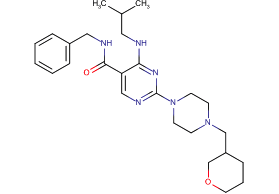
PF-4840154
CAS No. 1332708-14-1
PF-4840154 ( PF-4840154 | PF 4840154 | PF4840154 )
产品货号. M17247 CAS No. 1332708-14-1
PF-4840154 是大鼠和人 TrpA1 通道的有效选择性激动剂,可在小鼠中引发 TrpA1 介导的伤害行为,rTrpA1 和 hTrpA1 的 EC50 分别为 97 nM 和 23 nM。
纯度: >98% (HPLC)
 COA
COA
 Datasheet
Datasheet
 HNMR
HNMR
 HPLC
HPLC
 MSDS
MSDS
 Handing Instructions
Handing Instructions
| 规格 | 价格/人民币 | 库存 | 数量 |
| 2MG | ¥1296 | 有现货 |


|
| 5MG | ¥2770 | 有现货 |


|
| 10MG | ¥4026 | 有现货 |


|
| 25MG | ¥6423 | 有现货 |


|
| 50MG | ¥9153 | 有现货 |


|
| 100MG | ¥12312 | 有现货 |


|
| 200MG | 获取报价 | 有现货 |


|
| 500MG | 获取报价 | 有现货 |


|
| 1G | 获取报价 | 有现货 |


|
生物学信息
-
产品名称PF-4840154
-
注意事项本公司产品仅用于科研实验,不得用于人体或动物的临床与诊断
-
产品简述PF-4840154 是大鼠和人 TrpA1 通道的有效选择性激动剂,可在小鼠中引发 TrpA1 介导的伤害行为,rTrpA1 和 hTrpA1 的 EC50 分别为 97 nM 和 23 nM。
-
产品描述PF-4840154 is a non-electrophilic reference agonist of the TrpA1 channel. The TRPA1 channel is considered an attractive pain target based on the fact that TRPA1 knockout mice showed near complete attenuation of pain behaviors in some pre-clinical development models.
-
体外实验——
-
体内实验PF-4840154 (30 nmol; intraplantar) elicits TrpA1-mediated nocifensive behaviour in mouse. Animal Model:Female CD1 mice (25-30g) (In TrpA1+/+ mice)Dosage:30 nmol Administration:Intraplantar (i.pl) injection Result:Elicited robust licking behavior.
-
同义词PF-4840154 | PF 4840154 | PF4840154
-
通路Others
-
靶点Other Targets
-
受体rTRPA1|hTRPA1
-
研究领域Inflammation/Immunology
-
适应症——
化学信息
-
CAS Number1332708-14-1
-
分子量466.63
-
分子式C26H38N6O2
-
纯度>98% (HPLC)
-
溶解度DMSO : 50 mg/mL. 107.15 mM;
-
SMILESCC(C)CNc2nc(ncc2C(=O)NCc1ccccc1)N3CCN(CC3)CC4CCCOC4
-
化学全称N-benzyl-4-(2-methylpropylamino)-2-[4-(oxan-3-ylmethyl)piperazin-1-yl] pyrimidine-5-carboxamide
运输与储存
-
储存条件(-20℃)
-
运输条件With Ice Pack
-
稳定性≥ 2 years
参考文献
1.Ryckmans T,etal.Design and pharmacological evaluation of PF-4840154, a non-electrophilic reference agonist of the TrpA1 channel.Bioorg Med Chem Lett. 2011 Aug 15;21(16):4857-9.
产品手册




关联产品
-
Cyclo(Tyr-Val)
Cyclo(Tyr-Val) is a natural product for research related to life sciences.
-
Homodihydrocapsaicin...
Homodihydrocapsaicin I 是来自 Capsicum annuum L 的天然产物。
-
Transduction Peptide...
Transduction Peptide 1 (α II)



 021-51111890
021-51111890 购物车()
购物车()
 sales@molnova.cn
sales@molnova.cn







